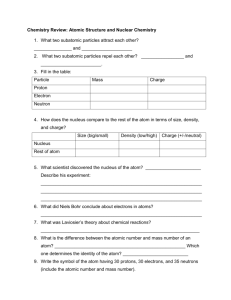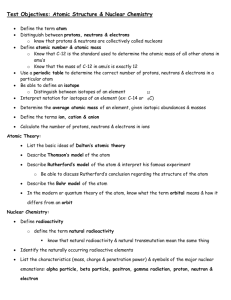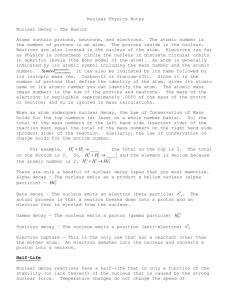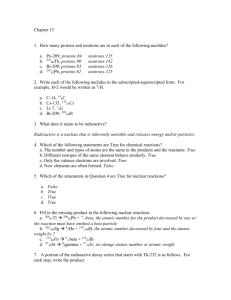Radioactive Decay Notes: Nuclear Reactions & Decay Types
advertisement
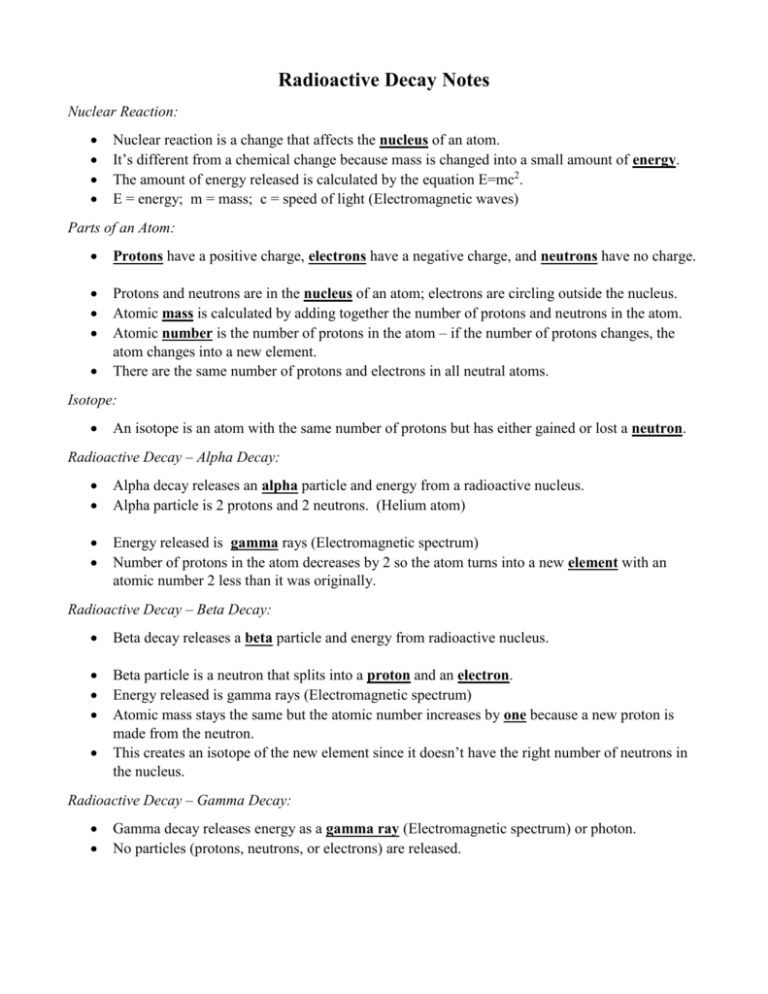
Radioactive Decay Notes Nuclear Reaction: Nuclear reaction is a change that affects the nucleus of an atom. It’s different from a chemical change because mass is changed into a small amount of energy. The amount of energy released is calculated by the equation E=mc2. E = energy; m = mass; c = speed of light (Electromagnetic waves) Parts of an Atom: Protons have a positive charge, electrons have a negative charge, and neutrons have no charge. Protons and neutrons are in the nucleus of an atom; electrons are circling outside the nucleus. Atomic mass is calculated by adding together the number of protons and neutrons in the atom. Atomic number is the number of protons in the atom – if the number of protons changes, the atom changes into a new element. There are the same number of protons and electrons in all neutral atoms. Isotope: An isotope is an atom with the same number of protons but has either gained or lost a neutron. Radioactive Decay – Alpha Decay: Alpha decay releases an alpha particle and energy from a radioactive nucleus. Alpha particle is 2 protons and 2 neutrons. (Helium atom) Energy released is gamma rays (Electromagnetic spectrum) Number of protons in the atom decreases by 2 so the atom turns into a new element with an atomic number 2 less than it was originally. Radioactive Decay – Beta Decay: Beta decay releases a beta particle and energy from radioactive nucleus. Beta particle is a neutron that splits into a proton and an electron. Energy released is gamma rays (Electromagnetic spectrum) Atomic mass stays the same but the atomic number increases by one because a new proton is made from the neutron. This creates an isotope of the new element since it doesn’t have the right number of neutrons in the nucleus. Radioactive Decay – Gamma Decay: Gamma decay releases energy as a gamma ray (Electromagnetic spectrum) or photon. No particles (protons, neutrons, or electrons) are released. Uses of Radioactive Decay – Gamma Rays: Radioactive decay is used in many ways: smoke detectors, sterilize bandages, test the thickness of metal sheets, find leaks in pipes, find the age of fossils, artifacts, rocks, bones, cloth, and the age of paints or canvases, and to find and treat diseases. Nuclear Fission: A nuclear fission is a reaction where a large, unstable nucleus (has too many protons and neutrons) breaks down into two smaller nuclei. The smaller nuclei are more stable but can still break down into smaller nuclei through nuclear fission. Creates 2 smaller atoms and releases 3 neutrons. Fission happens naturally with larger elements. Nuclear Chain Reaction: Nuclear chain reactions give off huge amounts of energy very quickly. Controlled reactions turn the energy released into electrical energy, like what we use in nuclear power plants. Uncontrolled reactions are what is used in atomic bombs. Advantages and Disadvantages of Nuclear Power Plants: Advantages: o Produces (makes) large amounts of energy from small amounts of energy. o Cost of fuel is less so the electricity made costs less. o Doesn’t produce greenhouse gasses, like carbon, or other air and water pollution, like fossil fuel plants do. Disadvantages: o Explosions and leaks can send large amounts of radioactive materials into the atmosphere and contaminate ground water, harm the environment, plants, animals, and humans. o Nonrenewable energy – set amount of uranium to use. o Produces radioactive waste that needs to be stored for thousands or millions of years before it is no longer deadly. Nuclear Fusion: Nuclear fusion is a reaction where the nuclei of smaller atoms combine to form a new, more massive nucleus. This type of reaction is produced in stars to create the energy (Electromagnetic waves) that are released. Changes small amounts of mass into larger amounts of energy. Two smaller hydrogen atoms are smashed together to create a helium atom.


